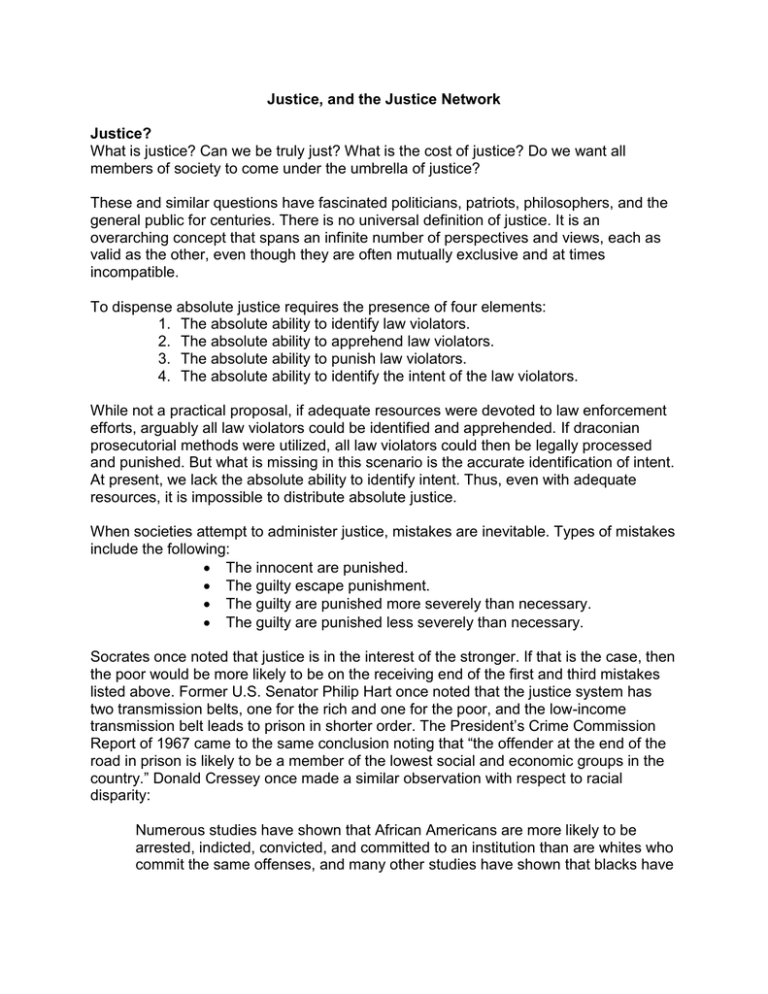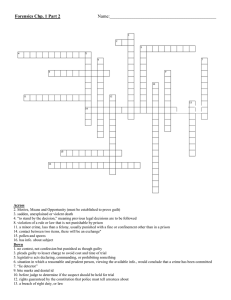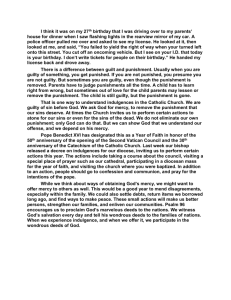"Justice, and the Justice Network"
advertisement

Justice, and the Justice Network Justice? What is justice? Can we be truly just? What is the cost of justice? Do we want all members of society to come under the umbrella of justice? These and similar questions have fascinated politicians, patriots, philosophers, and the general public for centuries. There is no universal definition of justice. It is an overarching concept that spans an infinite number of perspectives and views, each as valid as the other, even though they are often mutually exclusive and at times incompatible. To dispense absolute justice requires the presence of four elements: 1. The absolute ability to identify law violators. 2. The absolute ability to apprehend law violators. 3. The absolute ability to punish law violators. 4. The absolute ability to identify the intent of the law violators. While not a practical proposal, if adequate resources were devoted to law enforcement efforts, arguably all law violators could be identified and apprehended. If draconian prosecutorial methods were utilized, all law violators could then be legally processed and punished. But what is missing in this scenario is the accurate identification of intent. At present, we lack the absolute ability to identify intent. Thus, even with adequate resources, it is impossible to distribute absolute justice. When societies attempt to administer justice, mistakes are inevitable. Types of mistakes include the following: The innocent are punished. The guilty escape punishment. The guilty are punished more severely than necessary. The guilty are punished less severely than necessary. Socrates once noted that justice is in the interest of the stronger. If that is the case, then the poor would be more likely to be on the receiving end of the first and third mistakes listed above. Former U.S. Senator Philip Hart once noted that the justice system has two transmission belts, one for the rich and one for the poor, and the low-income transmission belt leads to prison in shorter order. The President’s Crime Commission Report of 1967 came to the same conclusion noting that “the offender at the end of the road in prison is likely to be a member of the lowest social and economic groups in the country.” Donald Cressey once made a similar observation with respect to racial disparity: Numerous studies have shown that African Americans are more likely to be arrested, indicted, convicted, and committed to an institution than are whites who commit the same offenses, and many other studies have shown that blacks have a poorer chance than whites to receive probation, a suspended sentence, parole, commutation of death sentence, or pardon. Justice should be the equitable access and applicability of rights, privileges, and opportunities, but in practice this is not always the case. That fact has caused a significant degree of contention in this country. Consequently, the enforcement of law and the administration of justice have become much more difficult tasks in the United States than they were some years ago. Systems of justice, in whatever societies or environments they develop, serve as mechanisms to enforce behavior standards deemed necessary to protect individuals and the general well-being of the community. Justice systems tend to possess a twofold role, namely, the prevention of certain activities and the apprehension of formal processing of individuals who have committed illegal acts. What distinguishes the justice system of one country from another is the form of the process and the extent of the protections offered in that process. A consensus has yet to be reached in this country as to the scope of the personal protection to be offered. What types of protection, freedoms, and rights should be given to what groups of people and how extensive should they be? When does the exercise of these protections and freedoms begin to flaunt the law? When does governmental control becomes excessive intervention? How much liberty is to be afforded to members of society and how much order should the state seek to maintain? Politicians, patriots, and philosophers have all grappled with these concepts for centuries. The Constitution of the United States, and more particularly the Bill of Rights, is a product of the collective reasoning of a group of individuals who debated these very issues more than 200 years ago. The document they produced extended personal liberties and restricted governmental intervention like no legal document ever had before. The Constitution grants American citizens certain rights and directs that these rights cannot be withdrawn without due process of law. There have been, however, rather intense disagreements over the years as to the proper definition of due process of law. In general, some advocate the need to limit the scope of due process protections and to expand the power of the State. Others clamor for an expansion of due process rights and the need to place powerful restriction on the State’s ability to interfere in citizens’ lives. These two perspectives are known as the crime control model and due process model respectively (Packer, 1968). The Due Process Model Under the due process model, the primary concerns are the protection of individuals, individual freedom, and general maintenance of liberty. People are considered basically good. Individuals are presumed innocent until proven guilty. Concern is with rehabilitating and reintegrating offenders back into society, and more particularly in assisting law violators to make a deliberate conversion to a more responsible lifestyle. The government intervenes and actively encourages, aids, and assists. Social welfare programs, low interest inner-city business loans, massive aid to cities, racial preference programs, income redistribution policies, Project Head Start, Job Corps, and student loan programs would all indicate a due process philosophy. Under the due process model, law enforcement officials conduct investigations according to strict guidelines. The courts take an active role in monitoring the operations of the police and the justice system in general. Every community has its own independent police department that brings a measure of local sensitivity and general humanitarian concern to law enforcement. The justice process is deliberate, formalized, thorough, and individualized. The due process model emphasizes treatment and not punishment of offenders. Treatment entails establishment of community-based alternatives to incarceration, such as pretrial release and pretrial diversion programs, neighborhood justice centers, probation, restitution, community service sentencing, parole, work release, half-way houses, and so on. Concern is with the normative, relative concept of fairness—doing the “right” thing. Police officers adopt a communitypolicing social service perspective, while probation and parole officers adhere to the advocacy model. Interest is in the development of long-term solutions at the cost of aggravating some nagging contingencies of the moment. There will be guilty persons who will escape punishment, and some guilty persons will be punished less severely than they should be. But on the other hand, there will be fewer innocent persons punished, and the number of guilty persons punished more severely than they deserve will also diminish. The Crime Control Model Under the crime control model, the primary concern is the immediate protection of society, in generally maintaining order. People are considered basically evil. Individuals are presumed guilty until proven innocent, and concern is with forcing conformity through an external deterrence system. Deterrence serves as the philosophic underpinnings of the entire model. The government rules through fear and intimidation, and the courts generally defer to the wishes of the law enforcement community. Law enforcement officials have large grants of discretionary powers and few if any restrictions placed upon their ability to collect evidence. They adhere to an aggressive, authoritarian enforcement philosophy. There are large numbers of law enforcement officers, and all law enforcement agencies are centrally organized as a national police force in a tight, closed bureaucratic structure. The justice process is quick and generally informal. Once guilt has been determined, punishment is meted out with swiftness, certainty, and severity. The crime control model promotes punishment, rather than treatment. There is frequent use of the death penalty, as well as frequent mandatory commitments of individuals to large, dehumanizing prisons, authorization of electronic surveillance, elimination of bail and adherence to a preventive detention perspective. There is no place under this model for diversion programs, rehabilitation programs, probation, or parole. Interest is in developing solutions to immediate problems. There will be some innocent persons punished, and some guilty persons will be punished more severely than they should be. But on the other hand, fewer guilty persons will escape punishment, and the number of guilty persons punished less severely than they deserve will diminish. The Justice Network Regardless of which model is chosen, the administration of social justice involves a definite cost. America has tended to lean towards the due process model and has long prided itself in offering a substantial measure of legal protection to the accused. At the philosophic core of the American system is the concept that individuals may be punished by the state only if an impartial and deliberate process proves they have violated a law. To facilitate that process, and in an attempt to yield some sense of equity in our society, a network of institutions and procedures has evolved in America. Some aspects of it were inherited and adapted from the British, while others have been uniquely American developments. In general terms, the justice system consists of four components: the legislature, the police, the courts, and corrections. While each has distinct tasks, these four divisions are by no means independent of each other. The legislature creates the laws that the police enforce. The courts deal with individuals whom the police arrest. The correctional system handles those sentenced by the courts. Success in reforming convicts can be determined to some degree by whether or not the “ex-con” returns to the system as an offender. Correctional and police practices are subject to court scrutiny, as are the laws enacted by the legislative bodies, which hold the purse strings for the entire system. It has been argued by some that well-meaning reformers frequently fail to grasp the interconnected nature of these four divisions and consequently fail to understand the impact their recommendations will have upon the system as a whole. Proposals for reform also frequently face serious challenges from within and outside of the system who have a vested interest in maintaining the status quo. As a result, it has been noted that while the justice system is often publicly reviled and attacked, ultimately it is left fundamentally unchanged. Today, the police, the courts, and the correctional components are all being inundated by an unprecedented number of cases. The justice system is being overtaxed as it tries to respond to problems of a nature and magnitude that are beyond its collective capabilities. Just how much more it can handle has become one of the greatest concerns of our times.



